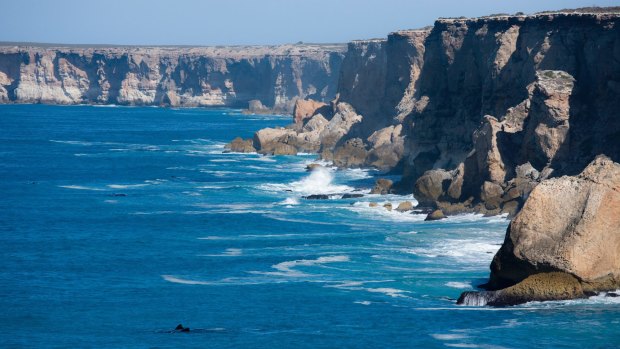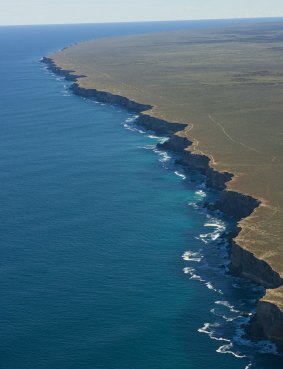This was published 7 years ago
Nullarbor road trip along the Great Australian Bight: Whale watching and limestone cliffs
By Daniel Scott
Ah, the joys of the Instagram age.
Not content with having rattled off 80-plus photographs of southern right whales on my camera, mostly mothers and calves riding the swell, beneath the Head of Bight, I'm now duty bound to capture the enchanting baleen dance on my iPhone, for my "Insti" followers. All 251 of them. Trouble is, where I'm standing, at the edge of the Nullarbor Plain, is one of the windiest places in Australia, and as I'm buffeted by an onslaught made in Antarctica, my phone is jolting up and down in my hands like an overactive puppy. I'm in tears too and sadly it's not because I'm overcome with glee at communing with whales, but because the so-called Nullarbor Doctor afternoon hurricane is making it impossible to focus on the tiny screen at the end of my fingers.
Then, with one gigantic smite of the onshore wind, my iPhone is ripped from my grasp and jettisoned down the cliffs, into the snarling Southern Ocean.

The Bunda cliffs form the southern edge of the Nullarbor Plain.Credit: iStock
Seriously, could any man be more stupidly addicted to social media than me, ignoring all the warning signs along the Nullarbor Plain?
The way, for instance, on the 290-kilometre drive from the South Australian seaside town of Ceduna to the Head of Bight, all the vegetation, from mallee scrub to saltbush, is almost bent double, leaning so heavily inland it's as if they are yearning for the serenity of the outback.
It's also called the Nullarbor for a reason, something to do with lack of trees, which might also be to do with the wind.

Aerial view of the southern edge of the Nullarbor Plain.Credit: South Australia Tourism
This massive tract of land straddling South Australia and the Western Australian border is, for many, a place of mystique, a rite of passage for those of a greying and nomadic bent. Otherwise, it's the domain of semi-trailers and road trains hurrying goods across our continent.
I don't get as far along the plain as I'd like to on my "whales and wheels' adventure, offered by the Ceduna-based Chinta Tours. But I see enough to convince me that if there are UFOs out there, this is where you'd see them. Why aliens would be interested in this gusty coastal plain, as opposed to say, the goings-on in Sydney and Melbourne suburbs, is another question.
This two-day, one-night tour is designed as a snapshot, if you can hold onto your camera, of the region and its regular gnarly-nosed visitors, southern right whales. Between May and November, the Great Australian Bight is home to this species, making it an excellent destination to see them.
The whales, which grow up to 18 metres, take their name from the fact that they only occur in the southern hemisphere and were, in the bad old days, the "right" species to harpoon.
Being slow moving, they were easy to catch, floated when dead and provided plentiful oil for lighting and other products. Between 1833 and 1845, 75 per cent of these whales, from a southern hemisphere population estimated at 100,000, were slaughtered.
Southern rights remain among the rarest whales, with only about 12,000 remaining. However, their numbers have been recovering since they were granted international protection in 1949 and they have increased by 7 per cent annually in recent years.
For me, this tour combines an opportunity of sighting a baleen whale for the fist time with visiting the Nullarbor, also a first.
After overnighting in Adelaide and grabbing one of the smaller of the gargantuan prime steaks available at Jock Zonfrillo's new restaurant, Blackwood, we fly on early the next morning to Ceduna, at the western end of the Eyre Peninsula.
Then it's into a hire car and onto Highway One, on a cloudless day, rolling into and out of Penong, 75 kilometres along our route, within an hour, and squandering our "last chance for discount beer".
The remainder of the journey to our base at the Nullarbor Hotel/Motel is, to borrow from Hamlet, "dull, flat and unprofitable", apart from the occasional buffet of wind.
But never for a moment is it Nullarbor-ing.
For geometrists, there is the pleasure of the unbending pinstripe of road reaching to the horizon and for others the lavish colour in the landscape, from the reddy-brown earth juxtaposed with blue sky, to the tousled grey-green bushes.
This south-western plain will also delight trivia lovers. It is the planet's largest section of limestone, at 200,000 square kilometres. The railway line that crosses it is the longest in the world at 476 kilometres, and it has Australia's longest section of straight road, at 146 kilometres. Oh, and in the 1950s, those clever colonialists, the British, blasted the hell out it and the Wangai Aboriginal population, with a series of nuclear tests, at Maralinga.
For a roadhouse, refuelling stop, and next last stop for discount beer, the Nullarbor Hotel is suitably unprepossessing.
Except that Julie, the formidable new manager, is upgrading the comfortable rooms and the plentiful and decent food.
Bit it still has character and a heartwarming dagginess, particularly in the bar, decorated in gaudy murals featuring such Aussie music icons as Jimmy Barnes, Kylie, AC/DC's Angus Young, Jason Donovan (?) and Kempsey's own Slim Dusty. With pool tables, a jukebox, passing truckies and nomads, and tales of a half-naked Nullarbor nymph scurrying around outside, it has all the ingredients for a big outback night.
When darkness falls, the scene is also set for a display outside, opening with the twinkling Southern Cross, continuing with a wonder of constellations and reaching a crescendo with shooting stars.
Or are they? And what's that dim orange glow inland, where there shouldn't be light?
We go to bed with few answers and wake to find a thick fog, with visibility down to trip-over-a-wombat-before-you-see-it. For those hoping to take Chinta Air's morning scenic flight, this is bad news.
Fortunately, we had taken our flight with young pilot Shannon Archibold, the Nullarbor's own Top Gun, the previous afternoon, venturing above the nearby Bunda Cliffs, a crumbling but resolute section of coast that looks as if it was hacked off by giant toothy fish. We saw the pinnacles and troughs of coastal sand mountains and that churning bathtub full of southern rights that is the Head of Bight.
We spotted about 15 big whales and baby whales, in the nursery close to shore, lolling through the swell, their broad blue-black backs shining on the ocean surface. It is here the calves learn the essentials before heading to Antarctica.
The following day we begin our journey back east by driving to Fowlers Bay for a whale watching cruise operated by Rod and Simone Keogh. He is a professional diver and former tuna wrangler off Port Lincoln and she is ex-navy. Fowlers Bay Eco cruises have an exclusive permit to come within 150 metres of whales.
While the bay has fewer southern rights than the waters off the Head of Bight, the two sets of mothers and calves seem to know the boat, and are therefore happy to stay awhile at the surface, never far away.
"It takes weeks to get this trust," Rod Keogh says. "This mum came into the bay before she gave birth and her calf was born three weeks ago."
Simone says: "Females tend to calve every three years, in the same place and babies come out about five metres long and weighing a tonne."
What goes on in the bay is one of nature's more impressive feeding frenzies, as the calves feast on 600 litres of mother's milk – the richest in the mammal kingdom – and put on up to 80 kilos a day. Mum, meanwhile, doesn't eat a sprat and can lose half her body weight before hightailing it to Antarctica to feed.
The time with the southern rights is special but it's almost eclipsed when we motor further out to sea and lower a hydrophone off the boat to tune into humpbacks swimming up to 10 nautical miles away.
Listening through headphones, we are treated to the mournful and endearing meowl of several male humpbacks. Then, on our return, we get close to an also rare Australian sea lion and several fur seals on rock ledges along the shore. They are taking a breather from marauding great white sharks.
Back on land, our last stop is appropriately, back in the "town of windmills", Penong, where a windmill museum founded by locals Bob Oats and Tim Hardy, opened on September 10.
After all efforts, including activating the "Find my iPhone" app on my iPad and a daring mission led by Top Gun pilot Archibold, have failed to recover my mobile phone, I pause beneath a revolving blade to offer a prayer to the gods of wind.
Then I let it rest, assured that in about 2285, my phone will be discovered by bubble-born tourists and, along with my Insti pics, provide hilarity at the primitive technology that once prevailed.
See also: 19 spectacular photos of South Australia from the air
See also: Across the Nullarbor on Australia's world-class train journey
TRIP NOTES
MORE INFORMATION
GETTING THERE
Qantas.com.au and virgin.com.au fly to Adelaide with onward flights to Ceduna available with rex.com.au.
TOURING THERE
Chinta Tours' two-day "Whales and Wheels" adventures run between July and September 30. Price from $1950 a person, including Adelaide-Ceduna return flights, one night dinner, bed and breakfast accommodation at Nullarbor Hotel/motel, 30-minute scenic flight, Fowlers Bay whale watch cruise and all-wheel drive vehicle hire (700 kilometres included) from Ceduna. Entry to Head of Bight whale watching platforms costs $15 extra. See chinta.com.au.
Daniel Scott travelled courtesy of Chinta Tours and South Australian Tourism Commission.
Sign up for the Traveller Deals newsletter
Get exclusive travel deals delivered straight to your inbox. Sign up now.